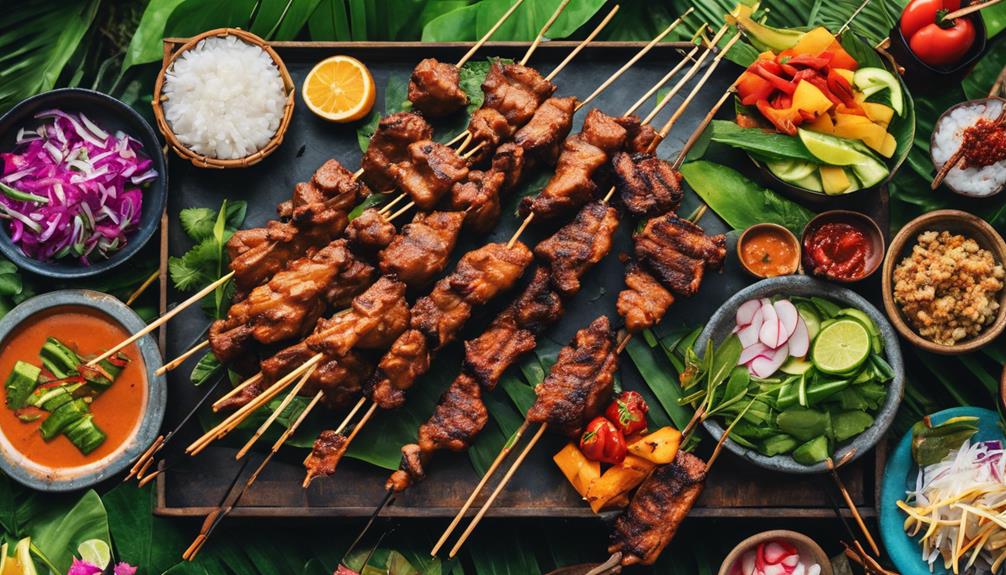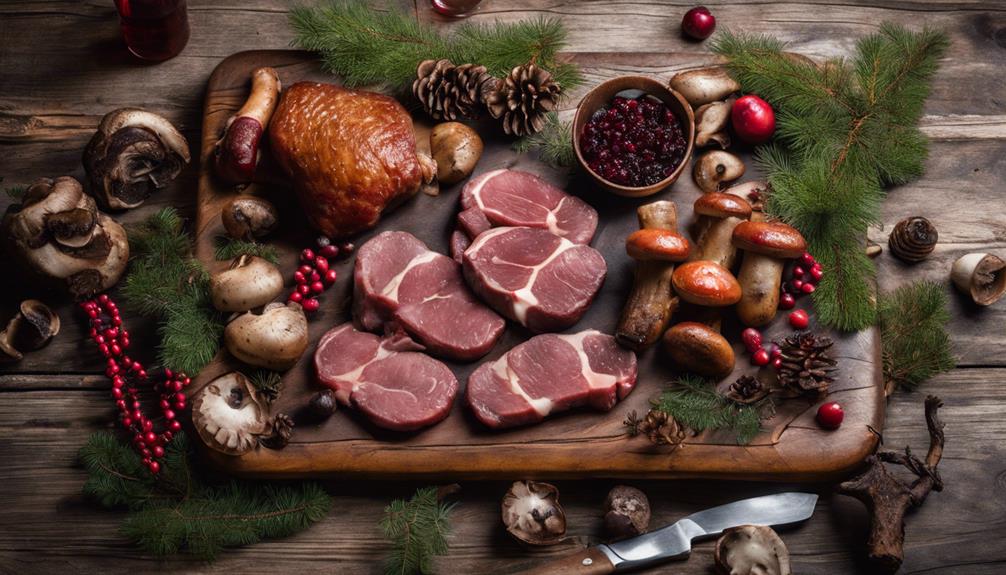Amazing Grilled And Bbq Meats Indonesian Cuisine Tips

Grilled And Bbq Meats Indonesian Cuisine Tips; To perfect your grilled and BBQ meats with Indonesian cuisine, embrace the bold flavors and unique techniques. Start by using key spices like lemongrass and turmeric in your marinades, letting your meats soak overnight for maximum flavor. Try sweet soy sauce (kecap manis) for a savory twist. Use high-quality charcoal for that smoky richness and create temperature zones on your grill. Limit flipping your meat to achieve perfect char marks and serve with invigorating tropical salads or spicy sambals. There’s so much more to explore in mastering the art of Indonesian grilling and BBQ!
Understanding Indonesian Flavors
When exploring Indonesian cuisine, you’ll quickly discover that its flavors are a vibrant tapestry woven from diverse ingredients and regional influences. Each dish showcases Indonesian flavor profiles that are anything but ordinary. You’ll find that sweet, spicy, sour, and savory elements play together in unique taste combinations, creating a culinary experience that’s both exciting and complex.
For instance, take the popular dish of nasi goreng. This fried rice isn’t just a simple comfort food; it’s infused with a medley of flavors from soy sauce, garlic, and chilies, making each bite a delightful surprise. Similarly, satay, skewered meat grilled to perfection, bursts with a sweet and savory marinade that highlights the balance of flavors characteristic of Indonesian cuisine.
As you probe deeper, you’ll notice how regions contribute their own twist to traditional dishes. In Bali, you’ll encounter a stronger emphasis on spices like lemongrass and turmeric, while in Java, the sweetness of palm sugar often takes center stage. This geographical diversity guarantees that every meal is an exploration of local ingredients and culinary heritage.
Essential Indonesian Spices
Exploring the rich tapestry of Indonesian flavors wouldn’t be complete without a closer look at the spices that bring these dishes to life. Indonesian cuisine is renowned for its vibrant and aromatic spice blends, which are essential to creating that authentic taste you crave. These blends often include a mix of ingredients like lemongrass, galangal, turmeric, and chili, each contributing to the depth and complexity of the flavors.
When you think of traditional spice usage in Indonesia, you might envision the careful balance of sweet, sour, and spicy elements. For instance, the popular spice blend known as “bumbu” can vary from region to region, showcasing local ingredients and preferences. You’ll find that combining spices like coriander, cumin, and nutmeg can elevate your grilled meats to another level, infusing them with warmth and character.
Don’t overlook the role of fresh herbs in these spice blends. Incorporating basil, cilantro, or kaffir lime leaves can add a revitalizing dimension that complements the robust flavors of the spices. When preparing your dishes, consider using a mortar and pestle to grind your spices, as this method releases essential oils and enhances the overall aroma.
Traditional Marinades Overview
Marinades play an essential role in Indonesian cuisine, infusing meats and vegetables with rich flavors before cooking. You’ll find that traditional marinades are a harmonious blend of textures and tastes, transforming ordinary ingredients into extraordinary dishes. One common base is sweet soy sauce, which adds a savory sweetness that perfectly complements the other flavors.
Spicy coconut marinades are popular, bringing a creamy texture and a touch of heat that tantalizes the palate. You can also create a marinade with tangy citrus, which brightens the dish and cuts through the richness of the meat. Don’t forget to add some garlic notes and ginger warmth; these ingredients are key to achieving that authentic Indonesian flavor profile.
Herbal infusions, like lemongrass and kaffir lime leaves, add depth and complexity, while chili heat can elevate the experience for those who love a kick. When you mix in ingredients that bring smoky flavors, you’ll create a marinade that’s perfect for grilling or BBQ.
The balance of umami richness is vital, as it enhances the overall taste and keeps your guests coming back for more. Experiment with these elements, and you’ll discover how to craft marinades that not only honor Indonesian traditions but also suit your preferences. With these tips, you’re ready to elevate your grilling game and impress everyone with your delicious creations.
Popular Grilled Meats
When it comes to Indonesian grilled meats, traditional skewers like satay stand out for their rich flavors. You’ll also notice that regional grilling techniques play a significant role in how these dishes are prepared and enjoyed. Let’s explore these delicious options that are sure to tantalize your taste buds.
Traditional Indonesian Skewers
The vibrant flavors of traditional Indonesian skewers, known as “satay,” beckon food lovers to indulge in this beloved culinary staple. You’ll find a delightful array of sate variations, each offering a unique taste experience. From the sweet and savory marinated chicken satay to the rich beef rendang skewers, there’s something for everyone to enjoy.
When preparing your skewers, pay attention to skewer presentation. Using bamboo skewers gives a rustic charm, while metal options provide a modern touch. Whichever you choose, make certain they’re soaked in water beforehand to prevent burning on the grill.
Marinades play a vital role in achieving that authentic flavor. A mixture of soy sauce, garlic, and spices will enhance your meat and make it truly irresistible. Grill your skewers over a medium flame, turning occasionally to guarantee even cooking.
Pair your satay with a luscious peanut sauce or a tangy sambal for a burst of flavor that complements the smoky, charred meat. Invite friends over, serve your skewers with a side of rice, and enjoy a feast that celebrates the essence of Indonesian cuisine!
Regional Grilling Techniques
Indonesian cuisine offers a rich tapestry of grilling techniques that vary by region, each showcasing the local flavors and cooking methods. When you think of Bali barbecues, picture succulent meats infused with sweet soy sauce and spices, grilled over coconut husks for that smoky aroma. In Java grilling, you’ll often find marinated chicken or beef skewers, served with a side of spicy sambal that packs a punch.
Sumatra techniques focus on bold, spicy marinades, often featuring lemongrass and turmeric, while Sulawesi methods highlight the use of fresh seafood, often grilled whole to preserve the natural flavors. Then there are the Lombok flavors, where fiery chilies take center stage, making every bite a thrilling experience.
In Kalimantan styles, you might encounter meats cooked in bamboo, imparting a unique taste that’s hard to resist. Nusa Tenggara practices often involve community grilling, where whole animals are slow-cooked in pits, creating tender and flavorful dishes. Finally, Aceh traditions shine with their rich spices and unique preparation methods, making for unforgettable grilling experiences. Embrace these diverse techniques to elevate your Indonesian grilling game!
Preparing Ingredients Properly
To create delicious Indonesian dishes, it’s essential to start with quality meats. You’ll want to understand effective marinating techniques and the spice blends that elevate your flavors. Let’s explore how selecting the right ingredients can make all the difference in your cooking.
Selecting Quality Meats
Choosing quality meats is essential for authentic Indonesian dishes, as the right cuts can greatly enhance flavor and texture. When sourcing meats, always look for freshness and quality. Visit local markets or reputable butchers where you can see, smell, and touch the meats before purchasing. This hands-on approach guarantees you get the best cuts available.
For grilling and BBQ, opt for cuts that have a good balance of fat and meat. Cuts like ribeye or sirloin offer tenderness and flavor, while chicken thighs provide juiciness and richness. If you’re working with pork, shoulder or belly cuts are fantastic for slow cooking and absorbing marinades.
Don’t overlook the importance of sourcing meats that are ethically raised. This not only contributes to better flavor but also supports sustainable practices. Also, consider the specific dish you’re preparing; certain meats pair better with unique spices and cooking methods typical in Indonesian cuisine.
Marinating Techniques Explained
When preparing your ingredients, marinating is an essential step that can elevate the flavors of your dishes. It’s not just about adding seasoning; it’s about infusing your meats with a blend of flavors that penetrate deeply. For the best results, consider using a citrus infusion as part of your marinade. Citrus fruits like lime or orange not only add brightness but also help tenderize the meat due to their acidity.
To maximize flavor absorption, you should aim for overnight soaking. This allows the marinade to work its magic, breaking down proteins and ensuring that every bite is packed with taste. When you’re ready to grill, make sure to remove the meat from the marinade and let it rest for a few minutes. This step helps the meat retain its juices, making your final dish even more succulent.
Spice Blends to Use
After mastering marinades, the next step in enhancing your Indonesian dishes lies in spice blends. These blends are vital for achieving the authentic flavor profiles that make Indonesian cuisine so unique. Start by exploring the spice origins of ingredients like turmeric, coriander, and lemongrass. Each spice brings its own character and history to your dishes, enriching them with depth.
To create a balanced spice blend, combine spices in appropriate ratios. For instance, mixing equal parts turmeric and coriander with a hint of cumin can yield a warm, earthy blend. Don’t forget to add chili powder if you’re looking to spice things up!
Experimenting with traditional combinations like bumbu rujak or bumbu Bali can also elevate your grilled meats. These blends often include spices like garlic, ginger, and shallots, which create complex layers of flavor.
When you’re ready to use your spice blends, toast them briefly in a dry pan to release their essential oils. This step intensifies their flavors, ensuring your grilled meats are aromatic and delicious. With the right spice blends, you’ll be well on your way to achieving Indonesian culinary perfection!
The Role of Kecap Manis
Kecap manis, a sweet soy sauce, plays a significant role in Indonesian cuisine that you won’t want to overlook. This thick, syrupy sauce is not only a staple condiment, but it also enhances the flavors of grilled and barbecued meats, making them irresistibly delicious. Originating from the Chinese soy sauce tradition, kecap manis has evolved over centuries, integrating local ingredients and tastes, which led to various kecap manis variations. These variations can include additional spices, herbs, or even fruit, offering unique flavor profiles that elevate your dishes.
When you incorporate kecap manis into your cooking, you’re tapping into a rich culinary history. Traditionally, it’s made by fermenting soybeans, and then adding palm sugar for that signature sweetness. This blend of salty and sweet flavors complements the smokiness of grilled meats perfectly. You might find it used as a marinade, dipping sauce, or even a glaze, giving your barbecued dishes an authentic Indonesian twist.
Don’t hesitate to experiment with different brands or homemade versions of kecap manis to discover which one suits your taste best. When you’re grilling, try brushing meats with kecap manis just before serving, or mix it into your spice blends for a deeper flavor. It’ll add a glossy finish and a sweet-savory kick that’s hard to resist. So, next time you fire up the grill, remember the power of kecap manis in transforming your Indonesian culinary creations!
Cooking Techniques Explained
When it comes to Indonesian cooking, mastering marinade preparation techniques is key to enhancing flavors. You’ll also need to pay attention to grilling heat management to achieve that perfect char. Let’s explore how these skills can elevate your dishes.
Marinade Preparation Techniques
Marinades play an essential role in Indonesian cuisine, infusing dishes with rich flavors and tenderizing proteins. When preparing your marinade, consider the different marinade types you’ll use. Wet marinades, often made with oils, soy sauce, or coconut milk, help add moisture and depth. Dry marinades, or rubs, rely on a mix of spices and herbs to create a flavorful crust.
Flavor balancing is vital in marinade preparation. You’ll want to combine salty, sweet, sour, and spicy elements. For instance, use soy sauce for saltiness, palm sugar for sweetness, lime juice for acidity, and chili for heat. Experiment with traditional ingredients like galangal, lemongrass, or turmeric to give your marinade an authentic Indonesian flair.
Let your proteins soak in the marinade for at least 30 minutes, but longer is often better—up to several hours or overnight—to allow the flavors to penetrate deeply. If you’re marinating fish or delicate meats, keep the time shorter to avoid overpowering them. Always remember to reserve some marinade before adding it to your proteins, as this can be used later for basting or as a sauce. Enjoy the process, and let your creativity shine!
Grilling Heat Management
Grilling is an art that requires careful heat management to achieve perfectly cooked Indonesian dishes. Start by understanding different heat sources, like charcoal and gas, and how they influence your grilling. Mastering charcoal management is key; you’ll want to create temperature zones by arranging coals for direct and indirect grilling. This technique allows you to sear meats over high heat while finishing them gently away from the flames.
Flame control is essential. You should adjust airflow to manage the fire effectively—this helps maintain consistent heat retention and prevents flare-ups. Using various grill types, such as kettle or offset smokers, can enhance your grilling experience, especially when it comes to smoke infusion.
Ensure your cooking surfaces are well-prepped; oil them slightly to prevent sticking. Regularly check the internal temperature of your meats to avoid overcooking. Remember, effective fire management will make a significant difference in the overall flavor and texture of your dishes. By honing these skills, you’ll not only elevate your Indonesian grilling game but also impress your guests with perfectly cooked meats every time.
Ideal Grill Setup
For the perfect Indonesian grilling experience, setting up your grill properly is vital. Start by choosing the right grill type for your needs. Charcoal grills are a popular choice for authentic Indonesian flavors, as they impart a smoky taste that complements the spices in your marinades. If convenience is your priority, gas grills offer quick heat and consistent temperatures, making them a practical option for busy cooks.
Once you’ve selected your grill type, focus on your fuel choices. If you’re using a charcoal grill, opt for high-quality lump charcoal or briquettes. These fuels burn hotter and longer, guaranteeing your meats cook evenly. You can also enhance the flavor by adding wood chips, such as mesquite or hickory, to the charcoal. Just soak the chips in water for about 30 minutes before using them, so they smolder and create that wonderful smoky aroma.
If you go for a gas grill, confirm you’re using the right propane or natural gas setup. Check for leaks in your connections and make sure the burners are functioning properly. This way, you’ll have a reliable heat source throughout your grilling session.
Lastly, arrange your grilling area to allow for both direct and indirect cooking. This setup lets you sear your meats over high heat and then move them to a cooler side to finish cooking, which is essential for achieving that tender, juicy texture found in many Indonesian dishes. With the right grill setup, you’re ready to create mouthwatering grilled masterpieces!
Temperature Control Tips
When cooking Indonesian dishes, knowing the ideal temperatures can make all the difference in flavor and texture. You’ll want to keep an eye on the doneness of your meat to guarantee it’s cooked perfectly every time. Mastering these temperature control tips will elevate your culinary skills and impress your guests.
Ideal Cooking Temperatures
Understanding ideal cooking temperatures is essential for mastering Indonesian cuisine, as it not only enhances flavors but also guarantees food safety. When grilling, you should aim for specific temperature ranges to ensure your meats are both delicious and safe to eat. For chicken, a safe internal temperature is 165°F (75°C), while pork should reach at least 145°F (63°C). Beef, on the other hand, can be cooked to various temperatures depending on your preference for doneness, but 135°F (57°C) is a good starting point for medium-rare.
For peak meat tenderness, searing your meats over high heat helps lock in juices, while finishing them over lower heat allows for even cooking without drying them out. Remember, grill safety is paramount; always use a meat thermometer to check the internal temperature and avoid cross-contamination by using separate utensils for raw and cooked meats.
Monitoring Meat Doneness
Monitoring meat doneness is essential for achieving the perfect texture and flavor in your Indonesian dishes. You can’t rely solely on cooking times; instead, you need to use a combination of meat thermometers and visual cues to guarantee your meats are cooked just right.
Start by inserting a meat thermometer into the thickest part of the meat, away from bone or fat, to get an accurate reading. For chicken, you’re aiming for an internal temperature of 165°F (74°C). For pork, 145°F (63°C) will give you that juicy texture.
While thermometers are invaluable, don’t overlook visual cues. Look for clear juices in chicken and a slight pinkness in pork, which indicates they’re not overcooked. Additionally, the meat should spring back when touched and have a nice caramelized crust.
Using these methods in tandem will help you master the art of doneness, elevating your Indonesian barbecue experience. Trust your tools and your instincts, and you’ll serve perfectly cooked meats that’ll impress everyone at your next gathering.
Achieving Perfect Char
Achieving perfect char on your grilled dishes can elevate your Indonesian cuisine to new heights. The key to mastering that ideal grilled flavor lies in understanding your char preferences and using the right grilling equipment. Whether you prefer a light sear or a deep, smoky crust, knowing how to achieve this can transform your meats.
Start by preheating your grill. If you’re using a charcoal grill, allow the coals to ignite completely and develop a white ash before placing your meat. For gas grills, set a high temperature and let it heat up for at least 10-15 minutes. This guarantees that your grilling surface is hot enough to sear the meat properly.
When it comes to your grilling equipment, using a cast-iron grill pan or a grill basket can help maintain even heat distribution, preventing hot spots that can lead to uneven charring. For those who love a smoky flavor, consider adding wood chips or using a smoker box to infuse your meats with delightful aromas.
Don’t forget to oil your grill grates before placing your meat on them. This prevents sticking and allows for better caramelization. As you grill, resist the urge to flip your meat too often; letting it sit will help develop those beautiful char marks. Finally, keep an eye on your grill’s temperature and adjust as needed to achieve your desired char preferences. With these tips, you’ll be well on your way to perfecting that mouthwatering char in your Indonesian dishes.
Pairing Side Dishes
When it comes to Indonesian cuisine, the right side dishes can elevate your meal from tasty to unforgettable. To complement your grilled and BBQ meats, consider incorporating a variety of vibrant side dishes that will enhance the flavors and textures on your plate.
Start with grilled vegetables, such as eggplant and bell peppers, seasoned with fresh herbs to add a burst of flavor. Tropical salads, featuring ingredients like mango and papaya, can offer a revitalizing contrast to the richness of the meats. Don’t forget about spicy sambals; these fiery condiments can bring an exciting kick to your meal and are essential to the Indonesian dining experience.
Rice options are a must-have, whether you opt for fragrant jasmine rice or coconut rice infused with pandan. For a twist, try pairing your grilled meats with noodle dishes, like stir-fried mie goreng, which add a delightful chewiness to your meal.
To further enhance the flavors, include pickled condiments that provide a tangy zest, balancing the savory nature of your grilled meats. Fresh herbs like cilantro and basil can also brighten up the dish. For a fun crunch, serve some crunchy snacks on the side, such as krupuk (crackers), which add texture and flavor.
Lastly, fruit salsas made with pineapple or cucumber can elevate your dish with their sweet and tart notes, creating a harmonious balance with the grilled meats. Enjoy the delightful symphony of flavors that Indonesian cuisine offers!
Serving Suggestions
To truly enjoy Indonesian cuisine, how you serve your dishes can make all the difference. The right plating techniques and serving styles can elevate your meal from ordinary to extraordinary. Start by choosing vibrant plates that contrast with the colors of your grilled meats. Use deep blues or earthy tones to highlight the rich hues of your dishes, creating an inviting visual experience.
For plating, consider the arrangement of your food. Stack or layer your grilled meats, allowing the juices to flow onto the plate, enhancing flavor and presentation. Garnish with fresh herbs like cilantro or mint, and add a sprinkle of toasted sesame seeds for added texture. This not only makes your dish aesthetically pleasing but also adds an aromatic element that tantalizes the senses.
When it comes to serving styles, think about family-style dining. Present large platters filled with grilled meats, allowing guests to serve themselves. This creates a communal atmosphere, encouraging conversation and sharing. Alternatively, if you’re hosting a more formal gathering, individual plates can be beautifully arranged with a single serving of each dish, along with a small side of sambal or a dipping sauce, to tantalize the taste buds.
Lastly, don’t forget the importance of side dishes. Arrange them in small bowls around the main platter, making it easy for everyone to access. With these serving suggestions, you’ll not only celebrate the flavors of Indonesian cuisine but also create a memorable dining experience for your guests.
Food Safety Practices
Food safety is vital in Indonesian cuisine, where the vibrant flavors often rely on fresh ingredients. To guarantee your grilled and BBQ meats are not only delicious but safe to eat, you’ll need to follow some key practices. Start by focusing on safe storage. Always keep raw meats in the refrigerator at temperatures below 40°F (4°C). If you’re marinating meats, do it in the fridge, not at room temperature. This prevents harmful bacteria from thriving.
When preparing your ingredients, hygiene practices are important. Wash your hands thoroughly with soap and water before and after handling raw meats. It’s also important to clean your cutting boards and utensils with hot, soapy water to avoid cross-contamination. Consider using separate cutting boards for raw meats and vegetables. This simple step minimizes the risk of spreading bacteria.
While grilling, use a food thermometer to verify your meats reach safe internal temperatures. For example, poultry should be cooked to at least 165°F (74°C), while ground meats should hit 160°F (71°C). Let the meat rest for a few minutes before serving; this allows the juices to redistribute and ensures any remaining bacteria are effectively killed.
Regional Variations in BBQ
How do regional flavors shape BBQ across Indonesia? Each region boasts its own unique take on grilling, influenced by local ingredients and cultural influences. In Java, for instance, you’ll find sweet and savory marinades made with kecap manis, a thick soy sauce, combined with regional spices that bring depth to the meat. In contrast, the spicy notes of Balinese BBQ often stem from sambal, a fiery chili paste, paired with traditional methods that include open-flame grilling.
Community gatherings often revolve around BBQ, where families share their favorite recipes passed down through generations. You’ll notice seasonal variations too—during festive periods, grilling festivals showcase the best of regional BBQ, celebrating family traditions and indigenous techniques. Each region might incorporate different meats, from chicken to fish, highlighting the diverse culinary landscape of Indonesia.
In Sumatra, for example, the use of lemongrass and turmeric adds a distinct flavor profile to grilled meats, while in Sulawesi, the emphasis might be on marinating meats in rich coconut milk. This diversity reflects not just a culinary choice but the heart of community life, where food brings people together.
As you explore these regional variations, embrace the chance to experiment with local ingredients and regional spices, allowing the essence of Indonesia’s rich BBQ culture to shine through in your grilling endeavors.
Enhancing With Garnishes
Elevating your BBQ experience in Indonesia often comes down to the garnishes you choose. The right garnish types can enhance both the visual appeal and flavor of your grilled meats, turning a simple meal into a feast. Fresh herbs like cilantro, mint, and basil not only add vibrant colors but also contribute to the flavor pairing that complements your dishes beautifully.
Utilizing garnish techniques, you can create stunning aesthetic presentations. For instance, a sprinkle of finely chopped fresh herbs can brighten up grilled chicken or beef, while slices of lime or chili can add a zesty kick. Don’t underestimate the role of texture contrast; crunchy fried shallots or toasted peanuts can provide an exciting mouthfeel alongside tender, juicy meats.
Remember the traditional accompaniments of Indonesian cuisine, such as sambal or pickled vegetables. They not only offer a burst of flavor but also have cultural significance, making your meal feel authentic. You can serve these alongside your main dishes for added zest and visual interest.
Incorporating vibrant colors through garnishes like sliced cucumbers or radishes makes your plate more inviting. This attention to detail not only enhances the overall dining experience but also shows respect for the rich culinary heritage of Indonesia. By thoughtfully choosing and applying garnishes, you’ll create a BBQ spread that’s both delicious and visually enchanting, ensuring your meal leaves a lasting impression.
Frequently Asked Questions: Grilled And Bbq Meats Indonesian Cuisine Tips
What Are the Best Cuts of Meat for Grilling in Indonesian Cuisine?
For grilling, you’ll want to choose tender cuts like chicken thighs, beef short ribs, or pork belly. Pair them with flavorful marinades and consider classic meat pairings to enhance your Indonesian barbecue experience.
How Can I Adjust Spice Levels for Different Palates?
To adjust spice levels for different palates, you’ll want to focus on spice blending and flavor balancing. Start with milder spices, gradually adding more heat until you reach a level that suits everyone’s taste.
What Are Common Vegetarian Alternatives to Traditional Grilled Meats?
You can try vegetarian skewers made with colorful veggies or marinated mushrooms. Grilled tofu also makes a delicious alternative—season it well to enhance flavor. These options satisfy your cravings without relying on traditional grilled meats.
Can I Use an Oven for Indonesian BBQ Recipes?
Yes, you can use an oven for Indonesian BBQ recipes. Utilize oven techniques like broiling or roasting, which enhance flavor infusion. Just marinate your ingredients well to achieve that authentic taste you’re aiming for.
How Do I Store Leftover Grilled Meats Safely?
To store leftover grilled meats safely, cool them quickly, then wrap tightly in plastic or foil. Place them in airtight containers for ideal meat preservation, and refrigerate within two hours to guarantee freshness.
Conclusion
Incorporating Indonesian flavors into your grilled and BBQ meats can elevate your cooking to new heights. By mastering essential spices, marinades, and preparation techniques, you’ll impress your family and friends with delicious dishes. Don’t forget to explore regional variations and add unique garnishes to enhance your meals. With proper food safety practices in place, you can enjoy a flavorful and memorable dining experience. So fire up that grill and get ready to savor the tastes of Indonesia!








